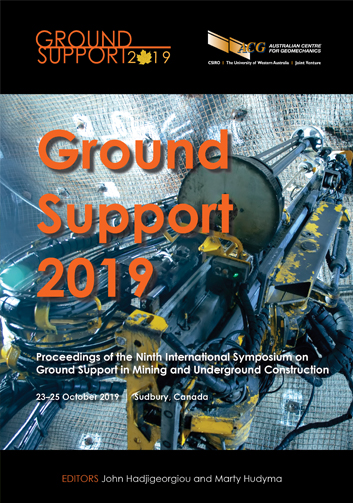Utilising database algorithms and three-dimensional visualisation software to optimise ground-control management

|
Authors: Veltin, KG; Preston, RP; Pakula, AL; Kennard, D |
DOI https://doi.org/10.36487/ACG_rep/1925_43_Veltin
Cite As:
Veltin, KG, Preston, RP, Pakula, AL & Kennard, D 2019, 'Utilising database algorithms and three-dimensional visualisation software to optimise ground-control management', in J Hadjigeorgiou & M Hudyma (eds), Ground Support 2019: Proceedings of the Ninth International Symposium on Ground Support in Mining and Underground Construction, Australian Centre for Geomechanics, Perth, pp. 593-600, https://doi.org/10.36487/ACG_rep/1925_43_Veltin
Abstract:
Records of manual scaling, ground-support checks and ground-support installations are commonly kept in handwritten daily logbooks, as required by mining regulations in Canadian jurisdictions and elsewhere. This process can be fraught with challenges in a large mature underground mine that has been subjected to changing ground-control approaches over its history. Accurate records of ground-support as-builts and of completed maintenance and rehabilitation are needed to show compliance with ground-control management-plan requirements. By combining the power of a database, three-dimensional (3D) visualisation software and simple scripting language driven by ground-support design criteria, the daily logbook can be uploaded to a system that helps the mine confirm ground-support compliance with its ground-control plans and provides a basis upon which to estimate material requirements and ground-support installation duration. The individual mine’s ground-support standards can be entered into the database, along with the mine geometry information and local geology, and when compared with records of installed ground support and maintenance records, can be used to digitally check on compliance in a spatial manner. When combined with modern mine design software, all data can then be viewed in 3D or on two-dimensional plan maps to assess where ground-support maintenance, rehabilitation or upgrades are required as well as where periodic check scaling is required. As ground support is installed and the ground-support system maintained, the database can be updated, and a workflow can be followed to visualise where work is required. Maintaining a record of ground-support information with such a tool can be simple and cost-effective and an efficient way to show compliance with a ground-control management system. This paper describes a case study of the application of such a system to a large mature future underground hard-rock gold mine that is to be rehabilitated to allow gradual closure of the property.
Keywords: underground ground support, mining ground support, ground-control management, quality control, check scaling, information management, Ground Control Management Plan (GCMP), ground support, ground control
References:
AutoDesk 2016, AutoCAD, version M.49.0.0, computer software, https://www.autodesk.ca
British Columbia Ministry of Energy and Mines 2017, Health, Safety and Reclamation Code for Mines in British Columbia, Victoria.
Golder Associates Ltd. 2018, Updated Ground Support Recommendations for Giant Mine Underground.
Government of Ontario 1990, Mining Act, Ottawa.
Statutes of Northwest Territories 2014, Mine Health and Safety Act, Yellowknife.
Surpac 2019, Geovia, version 6.9, computer software, https://www.3ds.com/products-services/geovia/products/surpac
© Copyright 2025, Australian Centre for Geomechanics (ACG), The University of Western Australia. All rights reserved.
View copyright/legal information
Please direct any queries or error reports to repository-acg@uwa.edu.au
View copyright/legal information
Please direct any queries or error reports to repository-acg@uwa.edu.au